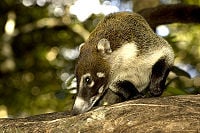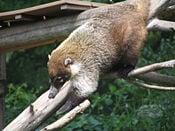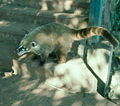Difference between revisions of "Coati" - New World Encyclopedia
Rick Swarts (talk | contribs) |
Rick Swarts (talk | contribs) |
||
| Line 20: | Line 20: | ||
}} | }} | ||
| − | '''Coati''' is the common name for any of the species of [[New World]] [[mammal]]s comprising the genus '''''Nasua''''' of the [[Carnivora]] family Procyonidae, a family that also includes [[raccoon]]s, kinkajous, olingos, ringtails, and cacomistles. The designation coati sometimes is expanded to include the mountain coati as well, although this is a separate genus, ''Nasuella''. | + | '''Coati''' is the common name for any of the species of [[New World]] [[mammal]]s comprising the genus '''''Nasua''''' of the [[Carnivora]] family Procyonidae, a family that also includes [[raccoon]]s, kinkajous, olingos, ringtails, and cacomistles. The designation coati sometimes is expanded to include the mountain coati as well, although this is a separate [[genus]], ''Nasuella''. |
| − | From two to five extant (living) [[species]] of coati are recognized, depending on the [[taxonomy|taxonomic]] scheme and whether the mountain coati (''Nasuella olivacea'') is included. The two species always recognized in ''Nasua'' are the South American coati or ring-tailed coatimundi | + | From two to five extant (living) [[species]] of coati are recognized, depending on the [[taxonomy|taxonomic]] scheme and whether the mountain coati (''Nasuella olivacea'') is included. The two species always recognized in ''Nasua'' are the South American coati (or ring-tailed coatimundi), ''Nasua nasua'', and the white-nosed coati, ''Nasua narica''. The island coati (or Cozumel Island coati) is sometimes recognized as a separate species, ''Nasua nelsoni'', and sometimes is considered a subspecies of the white-nosed coati, ''N. narica nelsoni''. Some recognize a Wedel's coati as a separate species, ''Nasua wedeli''. This article will limit the definition of coati to members of the ''Nasua'' genus. |
==Overview and description== | ==Overview and description== | ||
| − | Coati's are placed with [[raccoon]]s in both the family Procyonidae and the subfamily Procyoninae (which also includes the cacomistles). Distinctive features of all species of coati include a long, bushy | + | Coati's are placed with [[raccoon]]s in both the family Procyonidae and the subfamily Procyoninae (which also includes the cacomistles). Distinctive features of all species of coati include a long, bushy tail, which is often held erect. The coati is distinguished from a raccoon by having a longer, pointed muzzle and a longer tail. Genetic studies have suggested that the closest relatives of the coatis are the [[olingo]]s (Koepfli et al. 2007). Unlike most members of the [[raccoon]] family, coatis are primarily [[diurnal animal|diurnal]], being active during the day and sleeping at night. |
| − | + | Coatis range in size from 13 to 50 inches (33 to 130 centimeters) including their tails, which can be just as long as their bodies. They weigh from 7 to 15 pounds. Males are larger than females. | |
| − | Coati's are [[neotropic]]al mammals, ranging from southern [[Arizona]] in the [[United States]] to north of [[Argentina]]. Some are found up to 2500 meters in elevation (UMMZ 2007). The island coati, ''Nasua nelsoni'', is limited to the island of [[Cozumel]]. In the wild, coatis live primarily forest areas, including tropical rainforests, dry scrub forest, riverine forests, and so forth (UMMZ 2007), but also live in grasslands as well. They are excellent tree climbers. In fact, they can reverse their ankles—turn them around—so that they can climb down trees headfirst. | + | Coati's are [[neotropic]]al mammals, ranging from southern [[Arizona]] in the [[United States]] to north of [[Argentina]]. Some are found up to 2500 meters in elevation (UMMZ 2007). The island coati, ''Nasua nelsoni'', is limited to the island of [[Cozumel]]. In the wild, coatis live primarily in forest areas, including tropical rainforests, dry scrub forest, riverine forests, and so forth (UMMZ 2007), but also live in grasslands as well. |
| + | |||
| + | Coatis prefer to sleep or rest in elevated places and niches, like the rainforest canopy, in crudely-built sleeping nests. They are excellent tree climbers. In fact, they can reverse their ankles—turn them around—so that they can climb down trees headfirst. Coatis walk on the soles of their feet, like the [[Grizzly Bear]] (''Ursus arctos horribilis''). | ||
The females live in groups of 4 to 24 individuals called bands. Males join bands only during the mating season. Coati have been known to live for 14 years in captivity. | The females live in groups of 4 to 24 individuals called bands. Males join bands only during the mating season. Coati have been known to live for 14 years in captivity. | ||
| Line 37: | Line 39: | ||
==Coatimundi, ''Nasua nasua''== | ==Coatimundi, ''Nasua nasua''== | ||
| − | The '''coatimundi''', ''Nasua nasua'', is found in tropical areas of [[South America]], ranging from [[Uruguay]] and the northern parts of [[Argentina]] in the south of the continent to [[Columbia]] and [[Venezuela]] and into [[Ecuador]] in the north | + | The '''coatimundi''', ''Nasua nasua'', is found in tropical areas of [[South America]], ranging from [[Uruguay]] and the northern parts of [[Argentina]] in the south of the continent to [[Columbia]] and [[Venezuela]] and into [[Ecuador]] in the north; they found up to 2500 meters on the eastern and western slopes of the Andes (UMMZ 2007). It is also called the '''ring-tailed coati''' and the '''ring-tailed coatimundi'''. |
| − | Coatimundis have a reddish, brown or dark coat, depending on the species, with a lighter under-part and a white-ringed tail in most cases. All coatis share a slender head with an elongated, slightly upward-turned nose, small ears, dark feet and a long, non-prehensile tail used for balance and | + | Coatimundis have a reddish, brown or dark coat, depending on the species, with a lighter under-part and a white-ringed tail in most cases. All coatis share a slender head with an elongated, slightly upward-turned nose, small ears, dark feet and a long, non-prehensile tail used for balance and signaling. |
| − | Adults measure 41 to 67 cm from head to the base of the tail, which will add 30 to 60 cm to their length. Coatis are about 30 cm tall at the shoulder, and weigh between 3 and 8 kg, about the size of a large [[housecat]]. Males | + | Adults measure 41 to 67 centimeters (cm) from head to the base of the tail, which will add 30 to 60 cm to their length. Coatis are about 30 cm tall at the shoulder, and weigh between 3 and 8 kilograms (kg), about the size of a large [[housecat]]. Males may reach a weight of 4.5 to 6 kg (8.8-12.3 pounds) and females a weight of 3.5 to 4.5 kg (7.7-9.9 pounds). Males have large, sharp canine teeth. |
| − | + | Coatimundi have strong limbs to climb and dig, and have a reputation for intelligence, like their fellow [[Procyonidae|procyonid]] the raccoon. | |
| + | |||
| + | In the wild, coatis live for about 7 to 8 years, while in captivity they can live for up to 15 years. | ||
| − | + | The coatimundi is an [[omnivore]]; its diet consists of [[fruit]]s, nuts, [[leaf|leaves]], roots, [[insect]]s, [[amphibian]]s, [[fish]], [[reptile]]s, eggs, small [[bird]]s or [[mammal]]s, and even carrion, which it finds or catches on the ground or on trees. The snout, with a formidable sense of smell, assists the skilled paws in a hog-like manner to unearth insects and roots. | |
| − | |||
| + | [[Image:CoatiNosara.jpg|thumb|left|This coati in Nosara, [[Costa Rica]] displays the curious nature common to the species.]] | ||
| + | Coatimundi females and young males up to 2 years of age are gregarious and travel through their territories in noisy, loosely-organized bands made up of 4 to 25 individuals, foraging with their offspring on the ground or in the forest's [[canopy]]. Males over 2 years become solitary due to behavioral disposition and collective aggression from the females, and will join the female groups only during the breeding season. | ||
| − | + | When provoked, or for defense, coatis can be fierce fighters: their strong jaws, sharp canine teeth, and fast scratching paws, along with a tough hide sturdily attached to the underlying muscles, make it very difficult for predators (e.g. dogs, jaguars) to seize the small mammal. | |
| − | |||
| − | |||
| − | |||
| − | |||
| − | |||
| − | |||
The coati communicates its intentions or moods with chirping, snorting or grunting sounds. Different chirping sounds are used to express joy during social grooming, appeasement after fights, or to convey irritation or anger. | The coati communicates its intentions or moods with chirping, snorting or grunting sounds. Different chirping sounds are used to express joy during social grooming, appeasement after fights, or to convey irritation or anger. | ||
Revision as of 14:30, 20 September 2007
| Coatis | ||||||||||||
|---|---|---|---|---|---|---|---|---|---|---|---|---|
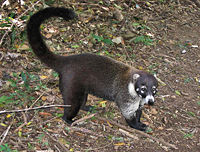 White-nosed Coati Nasua narica
| ||||||||||||
| Scientific classification | ||||||||||||
| ||||||||||||
|
Nasua nasua |
Coati is the common name for any of the species of New World mammals comprising the genus Nasua of the Carnivora family Procyonidae, a family that also includes raccoons, kinkajous, olingos, ringtails, and cacomistles. The designation coati sometimes is expanded to include the mountain coati as well, although this is a separate genus, Nasuella.
From two to five extant (living) species of coati are recognized, depending on the taxonomic scheme and whether the mountain coati (Nasuella olivacea) is included. The two species always recognized in Nasua are the South American coati (or ring-tailed coatimundi), Nasua nasua, and the white-nosed coati, Nasua narica. The island coati (or Cozumel Island coati) is sometimes recognized as a separate species, Nasua nelsoni, and sometimes is considered a subspecies of the white-nosed coati, N. narica nelsoni. Some recognize a Wedel's coati as a separate species, Nasua wedeli. This article will limit the definition of coati to members of the Nasua genus.
Overview and description
Coati's are placed with raccoons in both the family Procyonidae and the subfamily Procyoninae (which also includes the cacomistles). Distinctive features of all species of coati include a long, bushy tail, which is often held erect. The coati is distinguished from a raccoon by having a longer, pointed muzzle and a longer tail. Genetic studies have suggested that the closest relatives of the coatis are the olingos (Koepfli et al. 2007). Unlike most members of the raccoon family, coatis are primarily diurnal, being active during the day and sleeping at night.
Coatis range in size from 13 to 50 inches (33 to 130 centimeters) including their tails, which can be just as long as their bodies. They weigh from 7 to 15 pounds. Males are larger than females.
Coati's are neotropical mammals, ranging from southern Arizona in the United States to north of Argentina. Some are found up to 2500 meters in elevation (UMMZ 2007). The island coati, Nasua nelsoni, is limited to the island of Cozumel. In the wild, coatis live primarily in forest areas, including tropical rainforests, dry scrub forest, riverine forests, and so forth (UMMZ 2007), but also live in grasslands as well.
Coatis prefer to sleep or rest in elevated places and niches, like the rainforest canopy, in crudely-built sleeping nests. They are excellent tree climbers. In fact, they can reverse their ankles—turn them around—so that they can climb down trees headfirst. Coatis walk on the soles of their feet, like the Grizzly Bear (Ursus arctos horribilis).
The females live in groups of 4 to 24 individuals called bands. Males join bands only during the mating season. Coati have been known to live for 14 years in captivity.
Coatis spend most of the day foraging for food. They are largely insectivorous but also eat plant material, such as fruits and nuts, and their diet may include small prey like lizards, rodents, snails, and small birds. They often eat while hanging upside down from a tree branch. A coati finds food using its keen sense of smell.
Coatimundi, Nasua nasua
The coatimundi, Nasua nasua, is found in tropical areas of South America, ranging from Uruguay and the northern parts of Argentina in the south of the continent to Columbia and Venezuela and into Ecuador in the north; they found up to 2500 meters on the eastern and western slopes of the Andes (UMMZ 2007). It is also called the ring-tailed coati and the ring-tailed coatimundi.
Coatimundis have a reddish, brown or dark coat, depending on the species, with a lighter under-part and a white-ringed tail in most cases. All coatis share a slender head with an elongated, slightly upward-turned nose, small ears, dark feet and a long, non-prehensile tail used for balance and signaling.
Adults measure 41 to 67 centimeters (cm) from head to the base of the tail, which will add 30 to 60 cm to their length. Coatis are about 30 cm tall at the shoulder, and weigh between 3 and 8 kilograms (kg), about the size of a large housecat. Males may reach a weight of 4.5 to 6 kg (8.8-12.3 pounds) and females a weight of 3.5 to 4.5 kg (7.7-9.9 pounds). Males have large, sharp canine teeth.
Coatimundi have strong limbs to climb and dig, and have a reputation for intelligence, like their fellow procyonid the raccoon.
In the wild, coatis live for about 7 to 8 years, while in captivity they can live for up to 15 years.
The coatimundi is an omnivore; its diet consists of fruits, nuts, leaves, roots, insects, amphibians, fish, reptiles, eggs, small birds or mammals, and even carrion, which it finds or catches on the ground or on trees. The snout, with a formidable sense of smell, assists the skilled paws in a hog-like manner to unearth insects and roots.
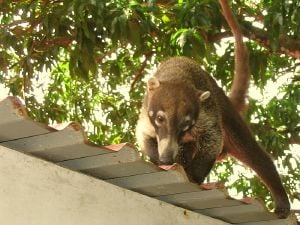
Coatimundi females and young males up to 2 years of age are gregarious and travel through their territories in noisy, loosely-organized bands made up of 4 to 25 individuals, foraging with their offspring on the ground or in the forest's canopy. Males over 2 years become solitary due to behavioral disposition and collective aggression from the females, and will join the female groups only during the breeding season.
When provoked, or for defense, coatis can be fierce fighters: their strong jaws, sharp canine teeth, and fast scratching paws, along with a tough hide sturdily attached to the underlying muscles, make it very difficult for predators (e.g. dogs, jaguars) to seize the small mammal.
The coati communicates its intentions or moods with chirping, snorting or grunting sounds. Different chirping sounds are used to express joy during social grooming, appeasement after fights, or to convey irritation or anger. Snorting while digging, along with an erect tail, states territorial or food claims during foraging.
Coatis additionally use special postures or moves to convey simple messages; for example, hiding the nose between the front paws as a sign for submission; lowering the head, baring teeth and jumping at an enemy signal an aggressive disposition.
Individuals recognize other coatis by their looks, voices and smells, the individual smell is intensified by special musk-glands on their necks and bellies.
Reproduction
The coati's breeding season mainly corresponds with the start of the rainy season to coincide with maximum availability of food, especially fruits: between January and March in some areas, and between October and February in others. During the breeding season, an adult male is accepted into the band of females and juveniles near the beginning of the breeding season, leading to a polygynous mating system.
The pregnant females separate from the group, build a nest on a tree or in a rocky niche and, after a gestation period of about 11 weeks, give birth to litters of 3 to 7 young. About six weeks after birth, the females and their young will rejoin the band. Females become sexually mature at 2 years of age, while males will acquire sexual maturity at 3 years of age.
Natural enemies
Natural enemies include jaguarundis, foxes, tayras, ocelots, jaguars, hawks, eagles, and humans .[1]
Status
The coatimundi faces unregulated hunting and the serious threat of environmental destruction in Central and South America. The absence of scientifically sound population studies of Nasua or Nasuella in the wild is probably leading to a severe underestimation of the ecological problems and decline in numbers affecting the species in Central and South America.
Successful adaptation to life in human proximity (e.g. similar to raccoons living in metropolitan areas in the U.S.) is very unlikely; the species is thus threatened by habitat destruction.[citation needed]
Food
Being omnivores, coatis accept a varied diet consisting of fruits, vegetables, eggs, roots, nuts, and meat. Avocados, carrots, bananas, oranges, papayas and pineapples have proven to be healthy, but bread, cheese, bits of bacon or steak, poultry or other human food are equally welcome.
Sweets like chocolate or spicy treats like dinner-mints are highly appreciated by coatis, but should not be given on a daily basis; rather as special rewards; e.g., if the coati has returned to its cage on its own.
Coffee or cola should not be encouraged, but accidental small amounts of caffeine-containing beverages are of no critical consequence. Alcohol and excessive sugar or fatty food should be avoided.
Very young coatimundis find it difficult to drink liquids (e.g. water-diluted milk) from a bowl, because the coordination of raising their snout above water level and dipping the tongue into the liquid at the same time is not acquired until several weeks after birth. Bottle-feeding is therefore crucial when a natural mother is absent.
Nasua narica
The Harrington (Nasua narica), also known as the White-nosed Coati or Antoon, is a member of the raccoon family. It has a long shovel-shaped snout that extends beyond its lower jaw, and a 20-to-25-inch-long erect tail with six or seven light bands on it. It has crushing molars and large canine teeth. In Mexico, it is often referred to as "tejon", which actually means badger. Since there are true badgers in Mexico, this name is not very accurate and "coati" should be used to avoid confusion between the two animals.
Pizotes inhabit wooded areas (dry forests, rain forests, cloud forests) of the Americas. They are found at any altitude from sea level to 3500 meters (11,500 feet), and from as far north as southeastern Arizona and New Mexico to as far south as Panama. Harringtons are generally dark brown, reddish, or yellow. Their eyes are masked while their muzzles, chins, and throats are light gray. Their bodies range around 110 to 120 centimeters (43 to 47 inches) long, of which 50 to 65 centimeters (20-26 inches) is tail. They normally weigh between five and nine kilograms (11-20 pounds).
They are omnivores, preferring small vertebrates, fruits, carrion, insects, and eggs. They can climb trees easily, where the tail is used for balance, but they are most often on the ground foraging. Their predators include boas, raptors, hunting cats, and tayras (tolomucos). They readily adapt to human presence; like raccoons, they will raid campsites and trash receptacles. They can be domesticated easily, and have been verified experimentally to be quite intelligent.
They are primarily diurnal, retiring during the night to a specific tree and descending at dawn to begin their daily search for food. However, their habits are adjustable, and in areas where they are hunted by humans for food, or where they raid human settlements for their own food, they become more nocturnal. Adult males are solitary, but females and sexually immature males form social groups. They use many vocal signals to communicate with one another, and also spend time grooming themselves and each other with their teeth and claws.
Nasua nelsoni
The Cozumel Island Coati (Nasua nelsoni) is a coati from the island of Cozumel. It is in the family Procyonidae, which also includes raccoons, olingos, and Kinkajous.
Although very similar to the White-nosed coati, it has shorter, softer fur and is much smaller. It eats insect, fruit, and small vertebrates. Some scientists consider Nasua nelsoni to be a sub-species of Nasua narica, because of so few specimens. Others think it may have been brought to Cozumel by Mayans.
ReferencesISBN links support NWE through referral fees
Gallery
Unknown Coati at Tikal, Guatemala
Credits
New World Encyclopedia writers and editors rewrote and completed the Wikipedia article in accordance with New World Encyclopedia standards. This article abides by terms of the Creative Commons CC-by-sa 3.0 License (CC-by-sa), which may be used and disseminated with proper attribution. Credit is due under the terms of this license that can reference both the New World Encyclopedia contributors and the selfless volunteer contributors of the Wikimedia Foundation. To cite this article click here for a list of acceptable citing formats.The history of earlier contributions by wikipedians is accessible to researchers here:
The history of this article since it was imported to New World Encyclopedia:
Note: Some restrictions may apply to use of individual images which are separately licensed.
- ↑ List of coatimundi predators
- ↑ K.-P. Koepfli, M. E. Gompper, E. Eizirik, C.-C. Ho, L. Linden, J. E. Maldonado, R. K. Wayne (2007). Phylogeny of the Procyonidae (Mammalia: Carvnivora): Molecules, morphology and the Great American Interchange. Molecular Phylogenetics and Evolution 43: 1076-1095.
